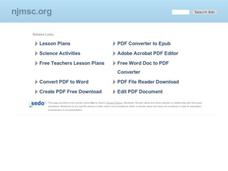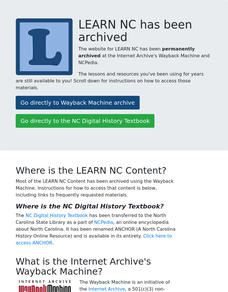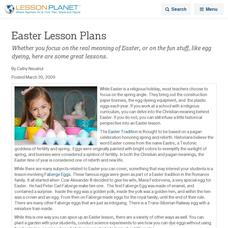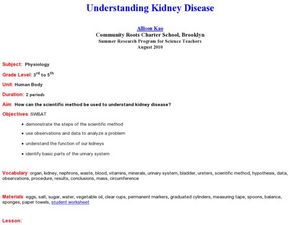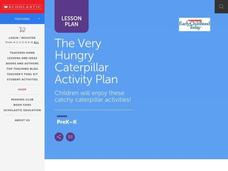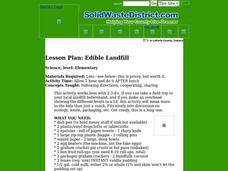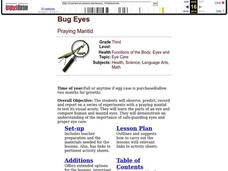Curated OER
Surprise Box Descriptions
Young scholars give oral definitions and descriptions. Each student takes a turn describing the contents of a plastic egg with a category plus attribute format. Other members have an opportunity to guess contents of the egg after...
Curated OER
Percents and Fractions
For this percents and fraction worksheet, students read short story problems, write an equation, and determine the percent or fractional part of a given number. They use the work backwards strategy to determine the initial number. This...
Curated OER
Something's Fishy
Fourth graders identify parts of a fish. In this fish anatomy lesson, 4th graders identify parts of fish in a group setting and then complete a worksheet about the parts of a fish.
Curated OER
Sense of Hearing
Students explore the sense of hearing. In this human biology lesson, students listen to the story Polar Bear, Polar Bear, What Do You Hear? and give examples of how they use their sense of hearing everyday. Students pass around plastic...
Curated OER
Easter Lesson Plans
Whether you focus on the real meaning of Easter, or on the fun stuff, like egg dyeing, here are some great lessons.
Curated OER
Denaturing Proteins
Students investigate how to denature proteins. In this denaturing protein lesson plan, students explore the different ways to denature proteins in the lab. They use heat, acids and bases, organic compounds and heavy metals to denature...
Curated OER
Beautiful Butterflies
Students discover the changes a caterpillar goes through in order to become a butterfly. In this early childhood lesson plan, students identify the various parts of the anatomy of a caterpillar and butterfly, as well as the changes...
Curated OER
What Causes Tooth Decay
Students investigate oral hygiene. In this personal health lesson plan, students discover the parts of a tooth and how to best protect them from disease. Students examine the effects of acids on tooth enamel and calcium.
Curated OER
Health Education: Germs
Fourth graders take part in a germ simulation activity. In this personal health lesson plan, 4th graders summarize methods for preventing the spread of germs that cause communicable diseases.
Curated OER
Packaging and Transport
Students examine the methods by which food is packaged and transported to their dinner tables. For this packaging and transporting lesson plan, students explore how machines help people grow food. Students also obtain knowledge about how...
Curated OER
The Spider's Life Cycle
Young scholars see that spiders have a life cycle, and reproduce by laying many eggs. We can count by ones, twos, fives, or as many as we want. They make two lists of animals on a chart.
Curated OER
Mosquito Life Cycles
Students gather mosquito eggs to record the mosquito life cycle using drawings, descriptions, and any other appropriate means. In small groups, they analyze and describe the process of complete metamorphosis. They classify mosquitoes...
Curated OER
Understanding Kidney Disease
Students experiment to determine information about kidney function. In this kidney function lesson, students use the scientific method to experiment with eggs, water, salt, sugar, and vegetable oil to simulate kidney function. They...
Curated OER
Mosquito Life Cycle
Seventh graders investigate the life cycle of the mosquito. In this life cycle instructional activity, 7th graders gain knowledge about the diseases mosquitos carry. Students breed mosquitos and investigate their eggs. Students...
Curated OER
Inertia
Students conduct a simple inertia demonstration by spinning a hardboiled and raw egg. They push a wagon to demonstrate inertia. They explore Newton's first and second laws of motion.
Curated OER
Simple Machines
Fourth graders examine a machine and how its parts work together. In this simple machines lesson, 4th graders work in groups to study different gadgets, analyze how the parts of the gadget work and draw sketches of the gadget. Students...
Curated OER
Don't Crack Humpty
Students investigate the engineering design process and the relationship between distance, time, and speed. Using a generic car base, small groups design a device that will protect an egg on or in the car as it is rolled down a ramp at...
Curated OER
Dinoset 2: Counting By 2's And 5's
Second graders practice counting by 2's and 5's. They complete five math problems counting by 2's and five math problems counting by 5's. They play a game by typing in a number that belongs in an egg and play By Five's to a 100.
Curated OER
The Very Hungry Caterpillar
Students engage in activities that extend Eric Carle's story The Very Hungry Caterpillar. In this The Very Hungry Caterpillar lesson plan, students use felt boards, dramatic play, calendars and egg carton creations, to expand on the...
Curated OER
Edible Landfill
Students identify the parts of a landfill. In this ecology lesson, students use various ingredients to create an edible landfill snack. For example, students use fruit roll-ups for plastic liner and crushed graham crackers for gravel.
Curated OER
Soak it up
Students complete a hands on activity using hard boiled eggs, food coloring, tape, cups, water, and a knife to show how permeability affects animals. In this permeability lesson plan, students complete this activity and learn how...
Curated OER
So You Think You're Tough
Fourth graders learn how to classify animals. In this invertebrates lesson, 4th graders discuss how we classify thinks into groups and move into a discussion about classifying animals. Students learn about the differences between...
Curated OER
Bug Eyes
Third graders observe, predict, record and report on a series of experiments with a praying mantid to test its visual acuity. They study the parts of an eye and compare human and mantid eyes.
